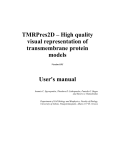Download Abstract 1 Introduction
Transcript
ElipSys Language Extensions to Support Numerical and
Real-Time Applications
Costas Halatsis
Maria Katzouraki Costas Mourlas
Manolis Gergatsoulis
University of Athens
Department of Informatics
Panepistimiopolis, TYPA Buildings
157 71 - Athens
Abstract
Numerical Processing is an application area for computer programming with great interest.
For this reason features as t in parallel logic programming that make numerical processing
more ecient and easier are described and proposals concerning their introduction in ElipSys
are presented.
We also discuss the real-time programming issues and the language support that should
be provided for building real-time applications. New language constructs and primitives are
proposed for this reason and then we examine the use of parallelism that ElipSys oers from
the real-time support point of view.
1 Introduction
In the following, we are going to present part of our contribution to the ESPRIT Project
EP2025, European Declarative System (EDS). The project's duration is 4 years (1989-1992)
and it is a collaboration between BULL (France), ICL (UK), SIEMENS (Germany) and
ECRC (Europe). A number of other European companies and universities are also involved,
including the Athens University as an associate partner of ECRC. The target of the EDS
project is to design and implement both the hardware and the software for a parallel information server. The EDS machine is a message passing multiprocessor with distributed store.
It consists of 4 to 256 Processing Elements (PEs), each one containing 64M to 2G bytes of
memory. Three declarative programming paradigms are supported, namely database, Lisp
and logic programming. ElipSys [BCDR+89, BCDR+90, DRSX90] is the parallel logic programming subsystem that aims at the development of complex applications. OR-parallelism,
data-parallelism, data driven computation, constraint satisfaction through nite domains and
NRCPS \Democritos", 153 10 - Aghia Paraskevi, Attiki
1
an interface to the EDS database server are some of the main characteristics of the ElipSys
language.
The eld of numerical processing is an important one in computer science. For this
reason, when we study a programming language, we often examine if the language provides
the necessary features for supporting numerical applications. In Prolog, little emphasis has
been given to features related to numerical processing. This is due to the fact that Prolog
was designed to be a programming language for Articial Intelligence applications. But if
we want to use Prolog as a general purpose language, we have also to examine the features
that Prolog provides for numerical applications programming.
In a parallel Prolog system, we have also to examine how we can exploit parallelism in
programs that perform numerical processing in order to speed up their execution.
Algorithms can be described declaratively using Prolog, but it is inecient to represent
data of real numerical problems using lists.
In this paper, we present some of the results concerning the proposed ElipSys extensions
which are related to numerical processing. We propose three approaches, dierent in nature.Firstly, an extension of ElipSys data parallelism, secondly,the incorporation of global
variables and arrays in ElipSys and thirdly, an interface between ElipSys and C.
One of the most interesting and challenging application areas of computer systems reside
in real-time domains. Many of real-time applications require also logic programming techniques for ecient implementation, e.g. real-time expert systems. Thus, there is a need to
extend a logic programming system with new constructs to support the expression of timing
constraints and other real-time features.
A dicult problem that arises in the real-time applications is the program verication.
Formal methods are dicult to be found to ensure that the timing requirements are met and
to predict the worst case execution time of the tasks.
Real-time applications are suitable to be coded in a parallel programming language due
to the fact that we can divide a real-time application into several cooperating tasks which
can run concurrently.
In this paper we also describe the extensions proposed for ElipSys in order to support the
implementation of real-time applications. We will also examine the use of the parallelism that
ElipSys oers in the above real-time extensions and the usefulness of a parallel environment
in real-time programming.
2 Numerical Processing
2.1 Characteristics of Numerical Problems
Numerical problems have particular characteristics and demand extended facilities in order
to be dealed with eciently by Prolog. Some of these characteristics and demands are
discussed in brief in this paragraph.
In most numerical problems there is a need for the representation and use of a large
amount of numerical data (e.g. vectors, matrices). In procedural languages, these data are
usually represented as arrays. In Prolog we have two choices. The rst one is to use lists.
This is the classical Prolog method. The second is to incorporate in Prolog facilities for
dening and using global arrays and data [Sep, Vax]. This approach is similar to that used
in procedural languages.
2
A problem related to data representation comes from the lack of destructive assignment to
Prolog variables. This leads to the need for a large amount of space even for small numerical
problems. The incorporation of global data in Prolog, which permit destructive assignment,
is also a solution to this problem.
Another charecteristic of numerical problems is that they are deterministic. This means
that backtracking is not used to nd possible alternative solutions. This observation poses
some questions about the suitability of Prolog, which is a non-deterministic language, to solve
numerical problems. Another question concerns the possible usefulness of OR-parallelism,
which is the main parallelism of ElipSys, in programs that solve numerical problems. We
have to note here that OR-parallelism is mainly used to nd all alternative answers to a
query, in parallel.
An important observation is that in numerical problems we have frequently to perform
the same operation on a large amount of data. In this paper, we try to nd ways to exploit
this kind of parallelism.
The constructs that we examine in the following are related to three dierent approaches
for solving numerical problems in Prolog.
1. The rst one is based on the use of lists to represent the problems' data. Using this
approach we believe that data parallelism with some extensions may be proved useful.
2. The second is based on the use of global variables and arrays for the representation of
data. Constructs for ecient manipulation of them are also proposed.
3. The third approach is based on cooperation of Prolog with a procedural language (C).
2.2 Data parallelism extensions
In most numerical problems there is a need to perform the same operation on a set of data.
For example, we often have to compute the vector sum of two vectors, to multiply a vector
by a number, or to perform the same operation on all the rows of a matrix. Such operations
could be carried out in all elements of a set in parallel since processing one element is
usually independent from the processing of the other elements of the set. In a sequential
Prolog system these operations are usually expressed through recursive Prolog procedures.
In program 1 we can see a typical example of these operations through an algorithm that
transforms a matrix into triangular. Matrices are represented as lists of lists.
Program 1
/* triangle(M,T) <-- T is the triangular matrix that is produced from M */
triangle([],[]).
triangle(A,[F|TA]) :- first_row(A,F,Rest), proc_rows(F,Rest,NewRest),
triangle(NewRest,TA).
/* first_row(M,F,R) <-- F is the first row of matrix M which
has its first element different than zero */
first_row([[C|Cs]|A],[C|Cs],A) :- C=\=0.
first_row([[0|Cs]|A],F,[[0|Cs]|R]) :- first_row(A,F,R).
3
/* proc_rows(F,M,Nm)<--turns to 0 the first column of matrix M giving Nm */
proc_rows(_,[],[]).
proc_rows(Fl,[L|Rest],[NewL|Ls]) :- procc_row(Fl,L,NewL),
proc_rows(Fl,Rest,Ls).
procc_row([C|Cs],[Ci|Cis],L) :- M is -Ci/C, product_num_vector(M,Cs,Lc),
vector_sum(Lc,Cis,L).
/* vector sum */
vector_sum([],[],[]).
vector_sum([A|As],[B|Bs],[C|Cs]) :- C is A+B, vector_sum(As,Bs,Cs).
/* multiplies all the elements of a vector by a number */
product_num_vector(M,[],[]).
product_num_vector(M,[X|Xs],[Y|Ys]) :- Y is M*X,
product_num_vector(M,Xs,Ys).
The processing of each row may be done independently and in parallel with the processing
of the other rows. The same holds for the elements of vectors in vector operations. Our
attempt was to express this kind of parallelism in the ElipSys. In this direction, we propose
the following extensions for data-parallelism [Heu89] and all-solution primitives.
An extension to all solution primitives in order to guarantee the order of solutions.
A new built-in data-parallelism predicate cor elements=4 which has the same declarative semantics as:
cor_elements(X,Y,[X|Xs],[Y|Ys]).
cor_elements(X,Y,[X1|Xs],[Y1|Ys]) :- cor_elements(X,Y,Xs,Ys).
This built-in generates pairs of X and Y of the corresponding list elements. A single
branche point with N branches (where N is the number of list elements) is created.
Using the ElipSys data-parallelism with the proposed extensions, we obtain Program 2.
In Program 2 the procedure proc rows of Program 1 has been replaced by the call
findall(NL,(par_member(L,Rest),procc_row(F,L,NL),NewRest)
In addition, the procedures vector sum and product num vector have been replaced by parallel versions. The necessity of the proposed extensions in order to guarantee the correctness
of the computations, is obvious.
The search tree that corresponds to Program 2 is shown in Figure 1.
Program 2
4
p
P
;@PP
; @ PP
p
p
p
p
p
C
A
CA
AC AC
p
p
p
p
p
p
p
p
p
p
p
p
p
p
p
p
p
p
p
p
p
p
p
p
p
p
p
p
p
p
p
p
p
p
p
p
A
C
CA
AC AC
p
A
C
CA
AC AC
p
p
A
C
CA
AC AC
p
p
A
C
CA
AC AC
p
p
p
p
A
C
CA
AC AC
p
C
A
CA
AC AC
p
p
p
p
A
C
CA
AC AC
p
p
p
p
p
p
PP
PP
@ ;
P
@
;
p
p
p
p
p
p
Figure 1: Search-\tree" for program 2
triangle([],[]).
triangle(A,[F|TA]) :- first_row(A,F,Rest),
findall(NL,(par_member(L,Rest),procc_row(F,L,NL)),NewRest),
triangle(NewRest,TA).
vector_sum(A,B,C) :- findall(Z,(cor_elements(X,Y,A,B), Z is X+Y), C).
product_num_vector(M,A,B) :- findall(Z,(par_member(X,A),Z is M*X), B).
2.3 Global data and Arrays in ElipSys
The second approach that we examine is to represent matrices using global arrays. To achieve
this, we have to extend ElipSys to support the denition of global data and constructs for
ecient use of them. The extensions that we propose are the following:
Global data denition built-in predicates
{ array def(Name,Dimension size,Type): Denes a global array with name
the atom Name and elements of type Type. The dimension and the size of the
array is dened in list Dimension Size.
{ var def(Name,Type): Atom Name is a global variable of type Type.
Global data manipulation built-in functions
{ val(Namef,Positiong): Returns the value of a global variable / array element
5
{ newval(Namef,Positiong) It is used only as a left hand side argument of the
is built-in. It assigns (destructive assignment) the value of the expression of the
right hand side of is, to the global variable / array element determined by Name
and Position. It is possible to mix logical and global variables in expressions.
Control structures (built-in procedures)
{ proc iter(Index var,Initial val,Final val,Step,Goal) Where Index var is
an uninstantiated variable, Initial val, Final val and Step are integers, Goal is
a Prolog goal. Goal is repeatedly called for all dierent values of Index var.
{ par proc iter(Index var,Initial val,Final val,Step,Goal) It is the same as
proc iter=5 except that all goals are executed in parallel.
{ proc until(Goal,Test) Where Goal, Test are Prolog goals. Goal is repeatedly
called until Test is true. This built-in procedure must be used in conjunction
with global variables. This is the only way for Test to succeed in some iteration.
An implementation of the matrix triangulation algorithm that we have previously presented, using global arrays and the proposed built-ins is presented in Program 3.
Program 3
:- array_def(a,[300,301],float).
:- array_def(buffer,[301],float).
:- var_def(row,short).
/* triangle(M, N) <-- makes triangular the matrix M which has N rows */
triangle(A,N) :- proc_iter(I,0,N,1,procc_rows(A,N,I)).
procc_rows(A,N,I) :- oneof(first_row(A,N,I)), J is I+1,
par_proc_iter(K,J,N,1,procc_row(A,N,K,I)).
first_row(A,N,I) :- val(A,[I,I])=\=0.
first_row(A,N,I) :- newval(row) is I, proc_until(incr(row),test(A,row)),
W is val(row), swap(A,N,I,W).
incr(L) :- newval(L) is val(L)+1.
test(A,L) :- val(A,[val(L),val(L)])=\=0.
/* swap(A,N,I,J) <-- swaps all elements of rows I and J of matrix A */
swap(A,N,I,J) :- par_proc_iter(M,I,N,swap_elem(A,M,I,J)).
swap_elem(A,M,I,L) :- newval(buffer,[M]) is val(A,[I,M]),
newval(A,[I,M]) is val(A,[L,M]),
newval(A,[L,M]) is val(buffer,[M]).
6
procc_row(A,N,K,I) :- Num is -val(A,[K,I])/val(A,[I,I]), N1 is N+1,
par_proc_iter(J,I,N1,1,proc_elem(Num,A,I,K,J)).
proc_elem(Num,A,I,K,J) :- newval(A,[J,K]) is val(A,[J,K])+Num*val(A,[I,K]).
Introduction of global arrays and data in a parallel Prolog system is more complex than
in a sequential one. This is due to the problem of sharing them and controlling their updates.
In sequential Prolog systems the usefulness of global data often relies on the user's knowledge
of the sequence of the modications of the values of global data. The problem arises when
global data in a parallel environment are shared between parallel processes which explore
dierent OR-brances of a procedure. Then, the sequence of modications of the values of
these data is not known at the time of writing the program (as it is the case in a sequential
Prolog). However, in some cases this is not a problem. As an example, we can mention the
use of a parallel procedure to manipulate dierent sections of a global array, which is the
case in the matrix triangulation algorithm of program 3. Another one is the storage of the
results of some processes in a global stack, the order of results being of no interest to us.
For cases in which the order of access of global data from dierent OR-processes is
signicant we propose a mechanism which ensures this order. This mechanism is presented
through an example which shows the use of global data for communication between ORprocesses.
The inability of independent parallel processes to communicate with each other has been
recognized as a problem of PEPSys [RR86] and an attempt [Rat88] was made to solve the
problem using the assert/retract mechanism. The example that we present was given in
[Rat88]. The problem is to nd the path connecting two points of a graph, which has the
minimum cost. If a number of processes explore each possible path of the graph in parallel,
then, when a process nds a solution with cost C, all the other processes which in that time
have found a part of a path with cost greater than C, is better to stop their work. For this
purpose a process communication mechanism is needed. The program of path nding is the
following.
:-var_def(cost,short).
:-parallel advance/4.
advance(EndNode,EndNode,[],PathCost) :- update_cost(PathCost).
advance(Node,EndNode,[NextNode|Path],PartialCost) :new_node(Node,NextNode,Cost),
NewPartialCost is PartialCost + Cost,
check_cost(NewPartialCost),
advance(NextNode,EndNode,Path,NewPartialCost).
update_cost(PathCost) :- wait(sem),
C is val(cost), C > PathCost, !,
newval(cost) is PathCost,
signal(sem).
update_cost(_) :- signal(sem).
check_cost(Cost) :- C is val(cost), Cost < C.
7
In procedure update cost we use the semaphore facility and the two built-in predicates
wait=1 and signal=1 (see paragraph 3.1) to forbid access to a global variable while the process
of updating takes place. If we do not use this mechanism it is possible that the following
situation appears: A process P1 nds a solution with cost 200 and calls the procedure
update cost. Let's suppose that the current value of the cost is 340. P1 gets the current
cost and compares it with 200. P1 nds that the cost that has found is less than the current
value of cost and decides to update cost. Before that, however, another process P2 nds a
solution with cost 250. P2 calls update cost which gets the current cost value 340. At that
time P1 updates the global variable cost with the value 200. P2 compares the value of cost
(340 > 250) and decides to update cost which nally takes the value 250.
Except for these applications, we believe [HKK+90] that global data and arrays may be
proved to be useful also to restrict the need of assert/retract and to transform some kinds of
AND-parallelism to OR-paralellism (storing the results of processing in global variables and
collecting them after the OR-processes have nished execution. We also provide the system
with the facility to pass global data to C functions.
2.4 ElipSys-C Interface
2.4.1 The need for the interface and its desirable characteristics
Most of the existing Prolog systems [Qui, BIM, C, Sep, Tur] provide the user with tools to
load and call programs written in a procedural language such as C, Fortran, Pascal, Basic,
Cobol, PL/1 and Assembly.
An interface to a foreign language from Prolog may be desirable for several reasons,
such as to speed up certain critical operations, to communicate with the operating system
and other programs, to combine Prolog with existing programs and libraries, to implement
algorithms that may be expressed easily in another language and to control the work done
by a procedural language through Prolog.
The key point in communication between Prolog and procedural languages is the data
passing from the one language to the other. The main problem in this communication comes
from the incompatibility between the data types of Prolog and the ones of the procedural
language.
In the ElipSys to C interface that we propose we took into consideration the following
desirable characteristics:
It must be independent of the specic hardware and must provide compatibility with
later ElipSys versions.
The user does not need to know anything about implementation details or the ElipSys
data representation.
The interface is low level enough, so as to give the user the ability to implement his/her
own built-in procedures.
The interface is general enough to permit passing and returning all ElipSys data types
to and from C.
It permits calling of existing C library functions without a lot of extra C code.
The interface should be ecient and not space consuming.
8
It should be user friendly.
2.4.2 The ElipSys to C Interface
The ElipSys to C interface allows the user to link an ElipSys predicate with a C function.
It also permits the denition of new ElipSys evaluable functions through C functions. At
present, the external predicates are deterministic. In the future, we will examine the possibility to support non-deterministic predicates as well.
In the ElipSys to C interface we concentrate on passing and use of all ElipSys data to the
C function. This includes logical terms as well as global data that we propose to be included
in the ElipSys language.
The interface supports the passing and automatic transformation of all atomic ElipSys
data types to the corresponding C data types providing user frendliness. This mapping is
carried out according to some transformation rules which are similar to the ones used by the
interface of Quintus Prolog [Qui] and BIM Prolog [BIM] with procedural languages.
The way of passing of general ElipSys terms and their use through functions that the
system provides is similar to these of BIM Prolog.
For global data supported by the ElipSys, we propose to have the same internal representation as in C. So, in order to pass a global variable or a global array to the C function,
just a pointer to the global variable or to the rst element of the global array is needed.
2.4.3 Argument Passing
Information is supplied to the interface through two built-in predicates external predicate=2
and external function=3 which correspond to external predicates and functions respectively.
These predicates are of the form:
: ;external predicate(hc namei; hprolog namei[(hp arg speci; hp arg speci; : : :)]):
and
: ;external function(hc namei; hprolog namei[(hf arg speci; hf arg speci; : : :)]; htypei):
The harg speci must be of a form that is dened as follows:
hp arg speci ::= (hkindi,htypei,hmodei) j (hkindi,htypei) j (hkindi)
hf arg speci ::= (hkindi,htypei) j (hkindi)
htypei ::= short j long j oat j double j atom j string
The information needed for argument passing concerns three dierent attributes:
The kind of the argument. The attribute hkindi may have one of the following values:
cv term (convertible term) If the argument is an ElipSys term which will be automatically converted by the interface to a corresponding C term
gl var (global variable) If the argument is a global variable
gl array (global array) If the argument is a global array
9
gp term (general Prolog term) If it is an ElipSys term which will not be converted by
the interface, but a pointer to it will be passed to the C function so that the latter
manipulate it through a predened set of functions that the interface provides
The type of the argument value. htypei provides the interface with information about
the C data type which the argument has to be mapped into by the interface.
The mode of the argument, that is,
i (input mode) If ElipSys sends a value to the C function
o (output mode) If ElipSys receives a value from the C function through this argument
r (return mode) If ElipSys receives a value through the C function's return value
Data passing is based on the following general rules.
For convertible terms (hkindi = cv term): If the mode is i (input) then the arguments
are passed by value (except for strings, that a pointer to a string is passed). If the
mode is o (output) a location of the declared type is created by the interface and a
pointer to it is passed to the C function. The C function is expected to store in this
place a value. On return to ElipSys the interface converts this value to a corresponding
ElipSys term and unies it with the corresponding argument of the ElipSys goal. For
r (return mode) no argument is passed to the C function but the value that the C
function returns is unied with the corresponding argument of the ElipSys goal.
For global variables (hkindi = gl var), a pointer to the location in which the data are
stored is passed to C function. The C function may read or update this location.
For global arrays (hkindi = gl array), a pointer to the location of the rst element of
the array is passed to the C function. The C function may read or update the elements
of this array.
For general Prolog terms (hkindi = gp term) a pointer to the ElipSys area that the
term is stored is passed to the C function. The C function may read or further instantiate this term or create a new term using a set of functions that the interface provides
for this reason.
In the case of atoms in output mode, a pointer to an unsigned long integer is passed to the
C function. It is assumed that the C function will overwrite this integer with the internal
representation of an atom. The ElipSys to C interface provides functions for translation
between internal and string representation of an atom.
As an example, let us suppose that we have a C function c gauss implementating the
Gauss elimination algorithm.
/* a:the problem matrix, sol: the solution vector, n:number of equations*/
c_gauss(a,n,sol)
float a[300][301],sol[300];
short n;
{ ... }
This function may be called from ElipSys passing pointers to arrays:
10
:- external_predicate(c_gauss,gauss((gl_array,float), (cv_term,short,i),
(gl_array,float)).
:- array_def(a,[300,301],float).
:- array_def(sol,[300],float).
:- gauss(a,300,sol).
/* after that call sol contains the solution */
Another possibility is to synchronize the execution of several C functions which solve
subparts of the problem through an ElipSys program and control the parallelism.
In Program 4 three C functions are presented, which perform subtasks of the whole
algorithm. Then the Program 5 is responsible to control the execution of the function using
the primitives that we have described in section 2.3.
vskip 0.5in Program 4
/* processing a single row in order to make matrix triangular */
c_proc_row(a,n,i,j)
short n,i,j;
float a[300][301];
{ .... }
/* computes solutions linear system using its triangular matrix */
c_compute_solutions(a,n,sol)
short n;
float a[300][301],sol[300];
{ .... }
/* gets the first row of the matrix with non zero value
in a specific cell */
c_first_row(a,n,i)
short n,i;
float a[300][301];
{ .... }
Program 5
:- external_predicate(c_proc_row,c_proc_row((gl_array,float),
(cv_term,short,i),(cv_term,short,o),(cv_term,short,o)).
:- external_predicate(c_compute_solutions,
c_compute_solutions((gl_array,float),
(cv_term,short,i), (gl_array,float)).
:- external_predicate(c_first_row,c_first_row((gl_array,float),
(cv_term,short,i), (cv_term,short,o)).
:- array_def(a,[300,301],float).
:- array_def(sol,[300],float).
:- var_def(row,integer).
/* gauss(A,N,Sol)<--A:problem matrix with N columns, Sol:solution vector */
gauss(A,N,Sol) :- triangle(A,N), c_compute_solutions(A,N,Sol).
11
triangle(A,N) :- proc_iter(I,1,N,procc_rows(A,N,I)).
procc_rows(A,N,I) :- c_first_row(A,N,I), K is I+1,
par_proc_iter(J,K,N,c_proc_row(A,N,I,J)).
3 Real-Time Processing
A Real-Time (RT) system is one which, given an arbitrary input (or event) and an arbitrary
state of the system, then the system always produces a response by the time it is needed. This
xed time that has elapsed until the response is provided, is dened in the problem statement
[LCSK88]. Tus, one of the main characteristics of a RT system is that the correctness of the
system depends not only on the logical results of the computation but also on the time at
which the results are provided [Sta88].
The application area of RT systems is very wide and interesting, ranging from small
applications like simple controllers, to large and complex systems for industrial and military
purposes. The most common applications reside in the area of control of sophisticated
equipments like ight control systems, automobile engines, nuclear power stations, robotics,
vision systems, systems found in intelligent manufacturing, the space station, aerospace,
nancial advice and medicine (patient monitoring).
Many of the applications have been implemented in low level languages (LLL) as often
as in high level languages (HLL). The implementation of a system in a low level language
oers some advantages such as the direct control of the external devices connected with
the computer, interrupt handling services , high execution speed and ecient use of memory. However, this also presents the well-known disadvantages of the LLL, which make the
implementation of a RT application extremely dicult.
The implementation of a RT application in a HLL is easier and faster but arises other
problems such as the diculties in handling the devices, interrupts and time. As Prolog is a
HLL designed for non-RT applications we have to enrich it with many constructs to support
the expression of:
Task manipulation
Timing constraints
Communication and synchronization between parallel processes
Interrupt handling mechanism
Exception handling mechanism
Although in this section we discuss RT programming issues and the language support
that should be provided for handling RT applications we also have to notice the importance
of the Operating System (OS) in the whole implementation of a RT system. Most of the
commands and primitives of the HLL related to process creation, communication between
processes, time handling and interrupt processing have to be translated into the corresponding system calls which nally manipulate these low level functions. Thus, the OS should
provide basic support for guaranteeing real-time constraints, process manipulation, control
over the interrupts, multitasking capability, control over tasks and a complete real-time clock
facility to ensure the correct manipulation of the timing requirements [LM88].
12
3.1 Extensions proposed for ElipSys
We rst consider that a RT application is more suitable to be implemented in the form of a
set of concurrent tasks in which the timing requirements and the inter-task communication
and synchronization are dened. Thus, we rstly have to dene what a task means in the
ElipSys and then to show the mechanisms for task manipulation, concurrent execution and
time handling.
We dene as a RT task in ElipSys an independent execution unit that consists of a set of
clauses, data associated with it, and timing constraints that determine the execution time
of the task. Each task has a priority and can exchange information through a well dened
communication mechanism.
A RT task is generated through a call of the built-in predicate gentask=5 which has the
form:
gentask(Tname; Starttime;Duration; Priority; Goal)
where
Tname is a descriptor which identies the new task and can be used to control its behaviour.
Tname is unique for each task.
Starttime is an ElipSys term which determines the start of execution and the period of the
task. The term can be of the form
start(and(Abs time; Event tree); Period)
or
start(or(Abs time; Event tree); Period)
As shown in the description of the above terms, the starting time may depend either
on absolute time or on a sequence of events or on a combination of both. Events are
used for synchronous communication between tasks and are described more precisely
in the following paragraphs. Here we see that an event can also cause the execution of
a task. Morover the period of the task may be dened if we have a periodic task.
Duration is an ElipSys term which determines the duration of the task and an exception
handler. The term is of the form
duration(Abs time; Time dur; Except goal)
The duration is dened either in absolute time (Abs time) or giving a time interval
(Time dur). The Except goal is a goal that is executed after a violation of the time
constraint.
Priority is the priority of the task
Goal is the goal that the task calls and constitutes the task code.
Other built-in predicates for task manipulation are:
1. priority(Tname; Priority): This call changes the priority of the task Tname.
2. suspend(Tname): This call suspends the execution of the task Tname. It can be
restarted by the call resume(Tname).
13
3. kill(Tname): It stops the execution of the task Tname.
In addition, some new constructs are used for time manipulation. For example we may
wish to delay a task for a time interval or read the time from the system's real-time clock.
The predicates proposed for this reason are:
1. duration(Tname; Duration): This predicate changes the previous time expression of
the task Tname and thus changes the time limit by which the task must be nished.
2. delay(Tname; N ): It delays the execution of the task Tname N time units.
3. delay(N ): It delays the execution of the calling task N time units.
4. wait(Tname list): It causes the calling task to wait until all the tasks in Tname list
have nished execution.
5. time(Hours; Min; Sec; Hundredths): It instantiates Hours; Min; Sec; Hundredths
with the system's RT clock.
6. date(Y; M; D): It instantiates Y; M; D with the year, month and day of the current
date.
All the above predicates are not backtrackable. In this way, when the program backtracks
to one of these predicates as gentask=5, it is the user's responsibility to call the prediate
kill(Tname) if the Tname is not needed any more.
Now we will describe some mechanisms and primitives that are needed for the inter-task
communication and synchronization in ElipSys.
A simple synchronization mechanism that can be used is the semaphore variable. A
semaphore can be created with the call create sem(S ), and can be accessed with the calls
wait(S ) and signal(S ).
wait(S )
implements the operation: if S > 0, then S = S ; 1, else suspend the execution of the calling
task.
signal(S )
implements the operation: if any task has been suspended after performing a wait call on
this semaphore, then mov
Cond is a predicate condition (goal statement).
These predicates handle the events as described below:
A goal
create event(E; S; SC )
solves only when some complementary goal
wait for event(E; R; RC )
is also reached in some other process, S unies with R, and then SC and RC evaluate both to
true. The same holds for wait for event(E; R; RC ) with respect to create event(E; S; SC ).
Apart from the synchronization feature, it's the same as if each of the two event goals was
replaced by (S = R; RC; SC ) where the clauses for RC and SC are dened in dierent
processes.
While a complementary goal has not been reached, either type of event goal hangs.
When both complementary goals are reached, but S does not match R or one of SC or RC
fails, then wait for event(E; R; RC ) fails and create event(E; S; SC ) hangs waiting for a
complementary goal to be reached again. The above is necessary to guarantee completeness
of search, as the one process hangs while the other backtracks to explore alternatives.
As shown in the above, synchronization relies on the fact that an event goal must be
reduced simultaneously with a complementary event goal. Communication is the outcome
of the unication of the Event info patterns.
A last mechanism that can be used for task communication is by global variables. We
can use two operations on a global variable: setting the variable with a value and getting the
value from the variable that is currently associated with it. These operations can be carried
out by the predicates introduced in paragraph 2.3. Communication is achieved having one
task assigning a value to a global variable and all the other tasks reading this value. In this
case a synchronization mechanism has to be used to ensure the correct writing and reading
of the global variables.
As we previously mentioned, one of the features that a RT language has to provide, is the
interrupt handling mechanism, that allows interrupt handlers denition. In the following we
describe a mechanism like the one that Sepia uses for interrupt handling [Sep]. The predicates
that we propose are:
1. def interrupt handler(N; Goal) that assigns the goal specied by Goal as the interrupt
handler for the interrupt identied by N . N is an operating system interrupt identier,
and thus, the denition of interrupt handler is OS dependent.
2. find interrupt handler(N; PredSpec) may be used to nd the current interrupt handler for an interrupt N .
3. interrupt(N ) The interrupt with number N is issued
4. disable interrupt(N ) disables interrupt with number N
5. disable interrupts disables all interrupts
6. enable interrupt(N ) enables the previously disabled interrupt N
7. enable interrupts enables all previously disabled interrupts
15
When an interrupt occurs, the system stops what it is currently doing, calls the interrupt
handler and when the handler exits, the execution is resumed at the point where it was
interrrupted.
3.2 Parallelism and Real Time extensions
As far as parallelism is concerned, we can say that Real Time applications have deterministic behaviour and require concurrent execution of many tasks. Thus, parallelism can be
presented when we create a new task using gentask=5 predicate and we want this task to be
executed in parallel with the already executing ones. OR-parallelism and Data-parallelism
that ElipSys oers, can be used inside the body of every task.
Every time that the predicate gentask=5 is called, the OS receives a system call which
creates a new task that is concurrently beeing executed with the original one. When a task
creates an event by the call create event=3 or asks for an event by the call wait for event=3
then a message is sent to the scheduler program (which is part of the OS) by a system
call. The scheduler also receives interrupt requests from the computer's interrupt system
and maintains lists of Ready, Suspended and Dormant tasks [LM88]. For example when a
task asks for an event or requests a system resource which is unavailable, then the scheduler
places this task in the suspended list and selects another task (if there is any) to be executed.
A task which is waiting for an event to occur or a resource to become available is not being
executed and therefore does not take up any CPU time. When the event occurs or the
resource becomes available the scheduler allows the task to continue execution.
4 Implementation Issues
As far as the numerical processing is concerned, we have to mention that some of the proposed
extensions like those for data parellelism may be implemented either as part of the ElipSys
itself or as library procedures. On the other hand, global data and interface to C must
be included in the languge. In the case of the interface, it may be provided a lower level
one upon which the more user friendly interface that we propose may be implemented. At
present, we have implemented global data and part of the proposed interface in a sequential
Prolog which has been developed at NRCPS Democritos [GK88] for experimental use.
As far as the RT extensions are concerned, we have to mention the strong dependencies
that exist between the proposed RT constructs and the operating system of the EDS machine.
The system supports the PCL, which is an interface between the language execution model
and the kernel and is used for the ecient managment of the computing resources and
the underlying hardware. The PCL provides primitives for process managment, interprocess
communication, synchronization and shared data. Thus, most of the RT language constructs
can be implemented using the corresponding PCL primitives. For example we can use PCL
primitives like create port(), connect sender to port(), async send to port() to implement
the proposed event communication mechanism. In addition, there is the need to enrich the
set of primitives of PCL with new primitives that manipulate time such as time-depended
process managment and periodic process creation.
Moreover, ElipSys uses an object-oriented approach in order to solve synchronization
problems caused by predicates with side-eects under parallel execution. For any set of
concurrent instructions that perform changes to a global memory or device, a managing
16
process to handle the needed synchronization is created. So many RT constructs can benet
from this ElipSys feature and solve the synchronization problems that arise.
Taking into consideration the features of PCL and ElipSys, the RT constructs can be
implemented quite easily and used eciently.
5 Conclusions
In this paper we examine the possibility to use ElipSys language for numerical processing.
Towards this, we propose some ElipSys extensions which we beleive that make numerical
processing in the ElipSys easier and more ecient. Three dierent approaches are presented.
The rst one is an extension of data parallelism and all solution primitives. This extension
can be useful in a wider area of applications and facilitates the expression of vector operations.
The second incorporates global variables and arrays in the ElipSys as well as constructs for
ecient use of them. Except for numerical processing, global variables may also be useful
in inter-process communication. The third extension concerns the communication between
ElipSys and C. The interface that we propose is designed so as to pass all ElipSys terms,
including global data, to C.
In addition, in this paper, we have proposed a set of RT extensions of ElipSys, in order
to support explicit timing constraints, periodic task creation, interrupt handling, communication and synchronization mechanisms. ElipSys extented with these features will be able
to be used for the implementation of many applications of RT domains which require knowledge based techniques that Logic Programming oers. Thus the required intelligence can be
added to the RT domains.
References
[BCDR+89] U. Baron, A. Cheese, S. Delgado-Rannauro, P. Heuze, M.-B. Iban~ez-Espiga,
and M. Ratclie. A rst denition of the ElipSys logic programming language.
Technical Report Elipsys/005e, ECRC, September 1989.
[BCDR+90] U. Baron, A. Cheese, S. Delgado-Rannauro, P. Heuze, M.-B. Iban~ez-Espiga,
and M. Ratclie. The ElipSys logic programming language. Technical Report
CA-53, ECRC, February 1990.
[BIM]
BIM Prolog Release 2.4. BIM, 1989.
[C]
C-Prolog User's Manual Versions 1.5 and 1.5+. April 1987.
[DRSX90] S. Delgado-Rannauro, K. Schuerman, and J. Xu. The ElipSys computational
model. Technical Report CA-51, ECRC, February 1990.
[GK88]
M. Gergatsoulis and M. Katzouraki. -Prolog:An implementation of Prolog. In
Proceedings of the 2nd Panhellenic Conference on Informatics, volume 2, pages
418{426, 1988.
[Heu89]
P. Heuze. Using Data-Parallelism in the ElipSys. Internal Report ElipSys-003,
ECRC, June 1989.
17
[HKK+90] C. Halatsis, M. Katzouraki, I. Karali, C. Mourlas, M. Gergatsoulis, and E. Pelecanos. ElipSys language extensions. Project Deliverable EDS.DD.5E.A001,
University of Athens, January 1990.
[LCSK88] T. Laey, P. Cox, J. Schmit, and S. Kao. Real-Time knowledge based systems.
AI Magazine, 9:27{45, 1988.
[LM88]
P. Lawrence and K. Mauch. Real-Time Microcomputer System Design: An
Introduction. McGraw-Hill, 1988.
[PN84]
L.M. Pereira and R. Nasr. Delta Prolog: A distributed logic programming
language. In Proceedings of the International Conference on Fifth Generation
Computer Systems 1984, pages 283{291, 1984.
[Qui]
Quintus Prolog User Guide and Reference Manual. Quintus Computer Systems,
Inc, 1987.
[Rat88]
M. Ratclie. Two extensions to the PEPSys logic programming language. Technical Report pepsys/28, ECRC, June 1988.
[RR86]
M. Ratclie and P. Robert. PEPSy: A Prolog for parallel processing. Technical
Report CA-17, ECRC, April 1986.
[Sep]
Sepia 3.0 User Manual. ICL and ECRC, 1990.
[Sta88]
J.A. Stanko


































